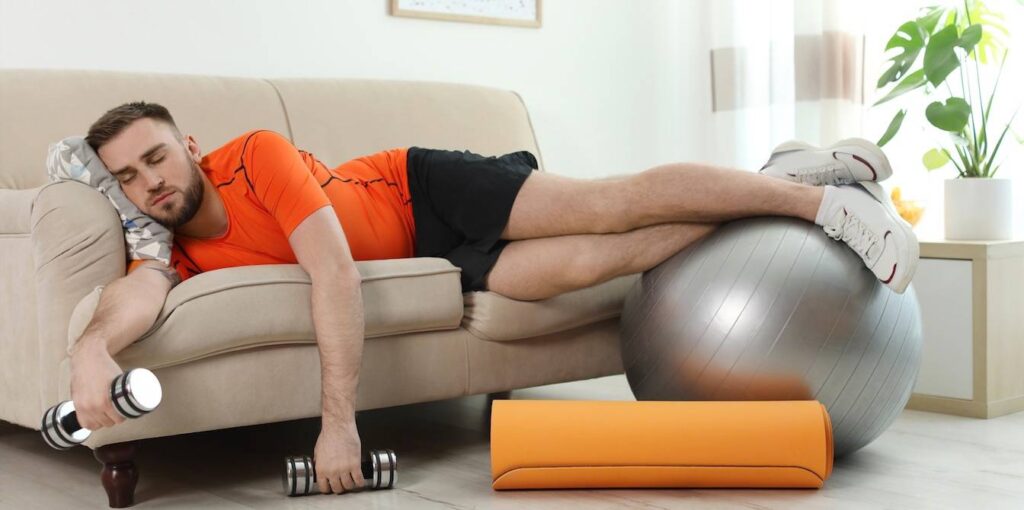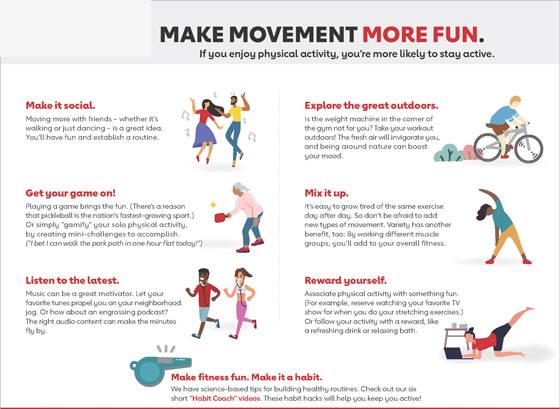Starting a fitness routine can feel overwhelming, especially when motivation is low. However, by setting small, achievable goals and integrating movement into daily habits, staying active becomes easier and more sustainable over time.

Understanding Motivation Blocks
Lack of motivation often arises from psychological, emotional, or physiological factors. The human brain is naturally wired to seek comfort and conserve energy. Consequently, when motivation is low, engaging in physically demanding activities like exercise can feel overwhelming. Additionally, research suggests that mental fatigue, stress, and even poor sleep quality contribute to reduced drive. These barriers often lead individuals to associate workouts with effort rather than enjoyment. However, understanding the underlying science of motivation can help reshape this perspective and make fitness more approachable.
The Role of Dopamine in Fitness
Dopamine, a crucial neurotransmitter, directly influences motivation and reward-seeking behaviors. This brain chemical is released when people experience pleasure, which includes the endorphin rush following physical activity. Unfortunately, those struggling with motivation often have lower dopamine levels or diminished dopamine signaling. As a result, exercise may not seem as rewarding, making it harder to build a consistent habit.
However, studies indicate that even small bursts of dopamine can create a positive feedback loop, ultimately increasing motivation. One effective strategy is to pair workouts with enjoyable activities, such as listening to upbeat music or exercising in a visually stimulating environment. This combination can trick the brain into associating fitness with pleasure rather than effort.
Practical Strategies to Overcome Fitness Apathy
Start Small and Set Attainable Goals
When motivation drops, setting large fitness goals often feels overwhelming. Instead of forcing yourself into an intense, hour-long workout, break exercise into smaller, manageable tasks. Research shows that short, achievable goals increase adherence and create a sense of accomplishment. In fact, behavioral psychology studies confirm that setting mini-goals makes progress feel more attainable. As a result, people are more likely to stay consistent with their workouts.
Moreover, smaller goals prevent burnout, which frequently occurs when individuals push themselves too hard too soon. Rather than diving into a demanding exercise routine, starting with brief, focused sessions allows the body and mind to adjust. Over time, these minor efforts accumulate, leading to long-term progress. Additionally, achieving small milestones builds confidence, reinforcing the belief that fitness is manageable. Because success fuels motivation, every completed workout—even a short one—strengthens the habit and encourages persistence.
The Power of Micro-Workouts
Micro-workouts offer an excellent way to ease into fitness without feeling burdened. These short bursts of movement, such as five-minute stretches, quick bodyweight exercises, or a brief jog in place, keep the body active without requiring too much effort. Furthermore, they help eliminate the mental barrier of committing to long sessions. Since these workouts require less time and energy, they feel more manageable and encourage consistency. Over time, motivation builds naturally, making it easier to extend these workouts into longer, more structured routines.
In addition to being time-efficient, micro-workouts also improve overall health. Research indicates that even short periods of exercise can boost cardiovascular health, increase metabolism, and enhance mood. Because they fit seamlessly into daily schedules, they eliminate common excuses related to time constraints. For instance, performing a few push-ups before showering or stretching during television commercials transforms idle moments into productive fitness opportunities. Not only do these mini-sessions contribute to physical health, but they also establish a mindset of movement, making it easier to incorporate longer workouts in the future.
Furthermore, micro-workouts reduce the likelihood of injury, which is often a concern for beginners. Unlike prolonged, high-intensity sessions that may strain muscles and joints, shorter routines allow for gradual progression. In fact, fitness experts recommend micro-workouts for individuals recovering from injuries or those new to exercise, as they provide a gentle yet effective way to improve strength and endurance. Consequently, these brief exercises serve as an accessible entry point for anyone hesitant to start a fitness journey.
Leverage the Science of Habit Stacking
Building new habits is easier when they are linked to existing ones. According to James Clear’s research on habit formation, this technique, known as habit stacking, seamlessly integrates fitness into daily life. For instance, performing squats while brushing teeth or stretching before drinking morning coffee transforms exercise into a natural part of the routine. This method reduces resistance because the brain already associates the existing habit with a specific cue.
Incorporating movement into daily activities creates consistency without requiring extra effort. For example, individuals who take phone calls while walking or perform calf raises while washing dishes increase their activity levels without setting aside separate workout time. Because habit stacking removes the need for additional decision-making, it prevents procrastination and reinforces routine behavior. Over time, these small actions compound, leading to noticeable improvements in strength, flexibility, and endurance.
Optimizing Your Environment for Exercise Success
Design a Motivating Workout Space
Your environment plays a crucial role in shaping motivation and exercise habits. A well-organized, visually appealing workout space makes physical activity feel less like an obligation and more like a natural part of your routine. Cluttered, dimly lit areas can create mental resistance, making it harder to begin a workout. However, transforming your space into an inviting, stimulating environment can encourage movement and consistency.
One simple yet effective strategy involves placing fitness equipment—such as yoga mats, dumbbells, or resistance bands—in visible locations. When workout gear remains in sight, it serves as a constant reminder to stay active. Furthermore, studies show that brighter, well-lit spaces promote energy and alertness, reducing feelings of fatigue before exercise. Because lighting influences mood and motivation, natural sunlight or warm-toned artificial lighting can make a significant difference.
Music and Sound Therapy for Energy Boost
Music profoundly influences brain function and emotional states. Research confirms that listening to high-tempo music before and during workouts enhances endurance, motivation, and overall performance. Because rhythmic beats stimulate the motor cortex, they help synchronize movement and reduce perceived exertion. As a result, people often feel less fatigued when exercising to music, making it easier to push through challenging workouts.
On the other hand, soothing background music, such as instrumental or nature sounds, can support recovery phases like yoga, stretching, or meditation. These sounds promote relaxation by lowering cortisol levels and improving focus. Therefore, selecting the right music for each stage of your workout can enhance both mental and physical performance. Because sound directly impacts motivation, curating an energizing playlist can turn a mundane workout into an engaging experience.
The Psychology of Workout Attire
The clothes you wear influence more than just appearance—they affect confidence, motivation, and overall workout performance. Cognitive psychology research suggests that wearing appropriate fitness attire creates a mental shift, reinforcing commitment to exercise. When individuals dress in athletic gear, they subconsciously prepare themselves for physical activity, making them more likely to follow through with their fitness plans.
Moreover, well-fitted, breathable workout clothing enhances comfort and mobility, reducing distractions caused by discomfort. Because restrictive or non-supportive clothing can hinder movement, selecting high-quality, functional apparel improves performance. Fabrics with moisture-wicking properties keep the body cool, while compression gear may provide additional muscle support and circulation benefits.
Additionally, color psychology plays a subtle yet impactful role in exercise motivation. Bright colors—such as red, orange, and yellow—are often associated with energy, strength, and determination, whereas cool shades like blue or green promote calmness and endurance. By intentionally choosing workout attire that aligns with personal goals, individuals can enhance their psychological readiness for exercise.
Ultimately, workout clothing serves as more than just a fashion statement. Since it influences both mindset and physical comfort, investing in proper athletic wear fosters a stronger sense of preparedness and dedication. By making small adjustments to attire, environment, and sensory experiences, individuals can optimize their workout spaces and boost long-term fitness motivation.
Using Social and Psychological Hacks to Stay Active
Accountability Partnerships and Group Fitness
Social support plays a pivotal role in sustaining motivation. Exercising with a friend or joining a fitness community fosters accountability, making workouts feel more enjoyable and less like a chore. Psychological research confirms that social reinforcement strengthens habit formation by decreasing perceived effort and increasing commitment.
The Role of Virtual Workout Communities
For those who prefer exercising alone, virtual workout communities provide an excellent alternative. Online fitness groups, mobile apps, and digital challenges offer social encouragement and friendly competition, both of which enhance adherence to workout routines. Behavioral science research indicates that individuals in virtual fitness groups are more likely to remain consistent with their fitness goals due to shared accountability.
Reward Mechanisms and Positive Reinforcement
Implementing a reward system is another scientifically proven way to boost motivation. While external rewards, such as new workout gear, can provide short-term motivation, intrinsic rewards tend to be more effective for long-term commitment. Tracking progress through fitness apps, celebrating small milestones, and recognizing personal achievements strengthen motivation by reinforcing a sense of accomplishment.
Overcoming Mental Barriers to Exercise
Addressing Negative Self-Talk
Negative thoughts often prevent individuals from starting or continuing an exercise routine. Cognitive-behavioral therapy (CBT) techniques can help reframe these thoughts and shift focus from failure to progress. For instance, rather than saying, “I’m too tired to work out,” replacing it with, “A short workout will boost my energy” fosters a more positive mindset. This mental shift encourages action rather than avoidance.
Mindfulness and Visualization Techniques
Practicing mindfulness before workouts reduces stress and enhances motivation. Sports psychology research suggests that visualization techniques, where individuals imagine themselves successfully completing a workout, improve actual performance. This mental rehearsal strengthens neural pathways, making the workout feel more achievable.
Managing Fatigue and Energy Levels
Chronic fatigue can lead to exercise avoidance. However, nutrition and hydration play critical roles in sustaining energy levels. A well-balanced diet rich in complex carbohydrates, lean protein, and healthy fats optimizes physical performance. Additionally, proper hydration prevents sluggishness and enhances endurance.

Enhancing Exercise Enjoyment for Long-Term Adherence
Choosing Activities That Align With Interests
Sticking to a fitness routine feels much easier when the activities match personal interests. Although traditional gym workouts provide effective training, they do not appeal to everyone. Many people struggle with the monotony of lifting weights or running on a treadmill, which often leads to inconsistent exercise habits. Instead, engaging in alternative forms of movement—such as dance, hiking, martial arts, or swimming—creates a sense of enjoyment rather than obligation. In particular, dance-based workouts, like
Zumba or hip-hop fitness, add an element of creativity, making them both engaging and physically demanding. Similarly, outdoor activities, including rock climbing or cycling, offer adventure while simultaneously improving endurance and strength. Because these activities align with personal preferences, they increase the likelihood of long-term adherence. As a result, fitness becomes an enjoyable experience instead of a tedious task.
Gamifying the Workout Experience
Incorporating elements of gaming into workouts significantly enhances motivation and engagement. Many fitness apps utilize point systems, challenges, and reward mechanisms to encourage users to stay active. Since competition often drives human behavior, these platforms transform exercise into an exciting, goal-oriented experience. For instance, some apps provide virtual badges or unlockable achievements for completing daily step goals, tracking progress over weeks, or outperforming previous workout records. Furthermore, interactive fitness games, such as virtual reality boxing or motion-controlled dance routines, blur the lines between entertainment and physical activity. This playful approach not only keeps workouts engaging but also reduces the psychological resistance associated with structured exercise programs. Consequently, individuals who struggle with motivation find it easier to stay consistent.
The Science of Outdoor Exercise
Exercising in natural environments offers unique physical and psychological benefits. Unlike indoor workouts, which often feel repetitive and isolating, outdoor activities provide fresh air, sunlight, and a sense of connection to nature. Scientific research shows that exposure to green spaces significantly lowers cortisol levels, thereby reducing stress and enhancing overall well-being.
Moreover, sunlight naturally boosts vitamin D production, which plays a vital role in maintaining strong bones and a healthy immune system. Because of these benefits, outdoor workouts tend to improve both mental and physical health more effectively than their indoor counterparts. Additionally, studies suggest that people perceive outdoor exercises as less strenuous, even when performing similar levels of exertion. This psychological effect makes them more likely to stick with their routines. In turn, regular participation in outdoor activities strengthens cardiovascular health, builds muscular endurance, and fosters long-term fitness habits.
Motivation is what gets you started. Habit is what keeps you going.
Jim Ryun
Conclusion: Embracing a Sustainable Fitness Mindset
Staying fit when motivation is low requires a combination of psychological, environmental, and physiological strategies. By leveraging small yet effective changes, such as micro-workouts, habit stacking, and social reinforcement, exercise can gradually become a natural part of daily life. Ultimately, consistency is more important than intensity, and small efforts add up over time. Rather than viewing fitness as a chore, shifting perspectives to see it as a form of self-care transforms the experience into a rewarding and enjoyable journey.


